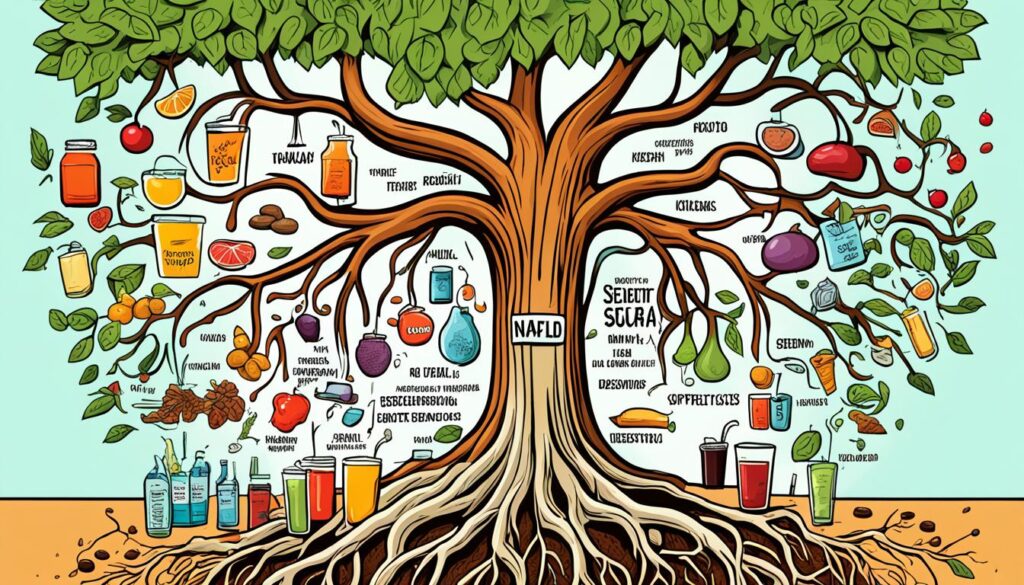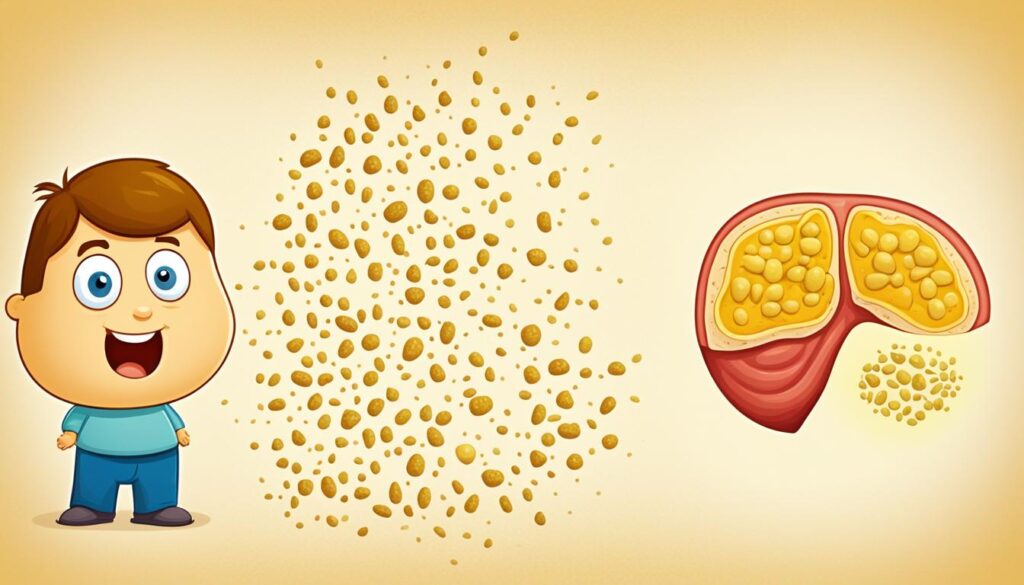Nonalcoholic fatty liver disease (NAFLD) is a liver issue affecting people who don’t drink much or any alcohol. It happens when there’s too much fat in the liver. This is often seen in folks who are overweight or obese. This condition varies in seriousness.
Table of Contents
ToggleFrom simple fatty liver to NASH, a more severe type leading to liver scarring and even cancer.
NAFLD doesn’t often show symptoms. But if it does, you might feel tired, have pain in the upper right belly, or just feel unwell. If it progresses to NASH or cirrhosis, you may notice itchy skin, a swollen belly, breathlessness, or skin and eyes turning yellow.
If you notice these symptoms and they don’t go away, see a doctor. It’s important for your health.
What is Nonalcoholic Fatty Liver Disease (NAFLD)?
Overview of NAFLD
NAFLD is when there’s too much fat in the liver. This is the top liver disease worldwide today. It’s common in places like the Middle East and the West, where obesity is a big issue. There are two main types: simple fatty liver and NASH. NASH is more serious, causing inflammation and harm to liver cells.
Types of NAFLD: Fatty Liver and NASH
In simple fatty liver, the liver holds too much fat. But there’s no inflammation or harm to the liver cells. NASH is worse. It means the liver has fat, inflammation, and liver cell injury. If NASH isn’t treated, it can lead to cirrhosis or liver cancer.
Prevalence of Nonalcoholic Fatty Liver Disease
Around 24% of adults in the U.S. have NAFLD. 1.5% to 6.5% have a severe type, NASH. The high rates of NAFLD are linked to obesity’s growth. Being overweight is a big reason for NAFLD.
Worldwide, 24% of adults have nonalcoholic fatty liver disease. In the U.S., this number is up to 30% of adults.
In the US, advanced fibrosis rates in people with NAFLD changed from 2005 to 2016. These rates differ among people of various races and ethnicities. A study from 2017 to 2018 showed 19% of US adults had NAFLD when tested with special equipment.
NASH is getting more common. It is the fastest growing reason people need new livers in the U.S.

nonalcoholic fatty liver disease symptoms
Common Symptoms of NAFLD
NAFLD often shows no symptoms. This is why it’s known as a “silent” liver disease. People can have it and not feel any different. But, when symptoms show, they might feel tired, not well, or feel pain in the upper right part of their stomach.
Symptoms of NASH and Cirrhosis
When NAFLD becomes NASH, symptoms may get worse. These might include itchy skin, swelling in the belly, or being out of breath. Other signs are swollen legs, spider veins on the skin, a bigger spleen, and yellow skin and eyes.
If NASH turns into cirrhosis, the liver is badly scarred. This can cause confusion, feeling sleepy, talking unclearly, or bleeding inside the body.
Causes and Risk Factors
Experts are still figuring out why some people get more liver fat. But they know NAFLD and NASH can be caused by different health issues. These include being overweight, having diabetes, and certain genetic factors.
Potential Causes of Fat Buildup in the Liver
Several diseases and health problems may increase NAFLD’s risk. These include a family history of fatty liver, high cholesterol, and insulin resistance. Also at risk are people with obesity, polycystic ovary syndrome, and type 2 diabetes.
Risk Factors for NAFLD and NASH
NASH is a bigger risk for those over 50 with certain genetic factors. Being obese, diabetic, or having signs of metabolic syndrome also ups the risk.

Complications of Untreated NAFLD
The biggest risk of NAFLD and NASH is severe liver scarring, called cirrhosis. When the liver fights NASH, it scars inside. This scarring, or fibrosis, can spread over time. This leads to cirrhosis, which causes serious health problems.
Cirrhosis brings fluid buildup in the belly, swollen veins, and confusion. It also affects the spleen and can lead to liver cancer or failure.
Cirrhosis and Liver Scarring
NAFLD and NASH can end in cirrhosis, which is very dangerous. Without treatment, it can cause liver failure. Cirrhosis also leads to fluid in the belly, enlarged veins, brain issues, and a higher risk of cancer.
Other Potential Complications
Untreated NAFLD and NASH can cause more than cirrhosis. They can also create issues like swollen esophagus veins. This is due to blocked blood flow. And they raise the risk of liver cancer, especially hepatocellular carcinoma.
Diagnosis of Fatty Liver Disease
NAFLD is diagnosed through various tests. The process usually starts with blood tests. These check on the overall health of your liver.
Blood Tests
Your doctor may order many blood tests. These include complete blood count and liver enzyme tests. They also look for signs of viral hepatitis and celiac disease. They will also measure your blood sugar and cholesterol. These tests give important clues about fatty liver disease.
Imaging Procedures
Doctors might suggest imaging tests too. These help see if there’s fat in your liver. They also check the amount of liver scarring. Tests like ultrasound, MRI, and CT scanning are common for this.
Liver Biopsy
If blood tests and imaging show advanced disease, a liver biopsy might be needed. This means taking out a tiny piece of liver to look at it closely. It helps confirm the diagnosis and shows how bad the liver damage is.

Treatment Options for NAFLD and NASH
To handle nonalcoholic fatty liver disease (NAFLD) and its advanced type, managing lifestyle is key. Focus on losing weight, even by a little. A reduction of 3-5% can make you healthier. For the best liver health, aim to shed at least 10% of your body weight.
Lifestyle Changes and Weight Loss
A diet full of fruits, veggies, and whole grains, with regular exercise, can be effective for NAFLD and NASH. Try to keep your food intake in check and hit 150 minutes of exercise weekly. This combo can help with losing weight and cutting down liver fat.
Medications and Therapies
Currently, there aren’t specific drugs for NAFLD or NASH. But, medicines for high cholesterol, high blood pressure, and diabetes show promise. Resmetirom (Rezdiffra) is a new drug for NASH with severe liver damage.
If NASH has caused serious liver scarring (cirrhosis), you might need a liver transplant. This can help your liver work better and lower risks of more health issues.
Prevention Strategies
To prevent nonalcoholic fatty liver disease (NAFLD), it’s key to stay at a healthy weight. This involves eating right and staying active. By doing this, you keep fat from building up in your liver, reducing your NAFLD risk.
Maintaining a Healthy Weight
Experts say about 24% of U.S. adults have NAFLD. Between 1.5% and 6.5% have the worse form, NASH. NASH hits those over 50, with certain genetic risks, obese, diabetic, or with high blood sugar. It also affects those with metabolic syndrome symptoms.
Dietary Recommendations
Eat lots of fruits, veggies, whole grains, and healthy fats. Also, watch your alcohol and avoid too much sugar. Stay away from sweet drinks like soda, sports drinks, juice, and sweet tea. Doing this helps lower your NAFLD risk.
Exercise and Physical Activity
Being active for at least 150 minutes a week can help. It aids in losing weight and getting healthy. But, check with your doctor before you start, especially if you usually don’t exercise.
Living with Fatty Liver Disease
If you have NAFLD or NASH, it’s vital to team up with your healthcare provider. Together, you can manage any other health issues you face. This includes diabetes, high cholesterol, and high blood pressure. Working on these problems can slow your liver disease’s progress.
Managing Other Health Conditions
To help your liver, keep diabetes, high cholesterol, and high blood pressure in check. This can lower the chances of serious liver problems. Make a solid plan with your doctor that covers all your health needs.
Avoiding Liver-Damaging Substances
Avoid alcohol if you have NAFLD or NASH. It can harm your liver further. Also, take care with over-the-counter meds, herbal supplements, and more. Always talk to your healthcare team before trying new drugs or supplements. They can make sure they’re safe for your liver health.
When to Seek Medical Attention
If you’ve been told you have NAFLD or NASH, seeing your doctor is very important. Make an appointment if you have symptoms that stick around, like feeling tired all the time, no interest in food, shedding lots of pounds, feeling weak, retaining water, or if you’re noticing blood in certain cases. These signs can mean your liver problem is getting worse. You might need more tests and a different kind of care.
Let your doctor know if things get worse. This could signal that you need more tests or a different plan of care. Finding issues early and treating them quickly can prevent big health troubles linked with NAFLD and NASH.

Being on top of your health can make a big difference. Work closely with your healthcare team to keep your liver in good shape. And if you’re worried about how you feel or your liver problem, don’t wait to contact your doctor.
Emerging Treatments and Clinical Trials
Researchers are looking into new ways to treat nonalcoholic fatty liver disease (NAFLD) and nonalcoholic steatohepatitis (NASH). They mainly focus on medicines that deal with the body’s metabolic and inflammatory systems. For example, they are studying the effects of vitamin E and some diabetes medicines on NASH patients.
There are clinical trials testing the safety and how well these new treatments work. A drug called CRV431 managed to reduce liver disease signs by 43.6%. NV556 might help stop liver fibrosis. The combination of CRV431 and NV556 also reduced liver damage and signs of disease in experiments.
Researchers are also looking into drugs like Lanifibranor to help improve NASH and control sugar levels. Drugs like Semaglutide and Lanifibranor, together with better eating, have shown to protect the liver in a NASH mouse model. Yet, another drug, IVA337, has been well-tolerated by people with diabetes and might be good for NASH too.
The scientific community’s work is continuing to make strides in dealing with NAFLD and NASH. These new treatments bring hope for better care and maybe even stopping the liver conditions from getting worse.
Fatty Liver Disease in Children and Adolescents
Nonalcoholic fatty liver disease (NAFLD) is on the rise in kids and teens. This is especially true for those who are overweight or obese. It can lead to serious problems if not dealt with early. Lifestyle changes are key for those with fatty liver disease.
This condition was mainly seen in adults before. Now, it’s the top liver disease in young people around the globe. If a child’s BMI is high, they’re more likely to get it. Other risk factors include things like insulin issues, family history, and not enough physical activity.
Most kids with this disease don’t show any signs. Some might feel a bit of pain in their upper-right stomach now and then. Doctors often find it during routine checkups. Changing what kids eat and getting them to exercise more is the main treatment. Without care, it can cause major liver damage and even failure over time. It’s a leading reason for liver transplants among grown-ups.

NAFLD, now known as metabolic-associated fatty liver disease (MAFLD), is the top chronic liver issue in children and teens. Being overweight or having trouble processing insulin raises your chances of getting it. Signs include belly pain, feeling tired, and trouble focusing. In its worst form, it can cause symptoms like yellow skin, itchy skin, and bruising easily.
Often, this disease is found by chance during a checkup. Eating well, losing weight, and getting more exercise can help. Kids need to be active for at least an hour every day. Good sleep is also crucial. Regular changes in lifestyle are the best treatment. Sometimes, a liver transplant might be needed. Right now, there’s no medicine for this, but living healthy helps a lot.
Dietary Supplements and Alternative Therapies
Vitamin E and Antioxidants
Research shows that vitamin E and antioxidant supplements could help those with NAFLD, especially if they don’t also have type 2 diabetes. These supplements might lessen liver inflammation and stress. However, experts say more studies are required. They also advise against using vitamin E if the liver scarring is severe or you have diabetes.
Caffeinated Coffee and Its Potential Benefits
Drinking caffeinated coffee regularly might lower the chance of getting NAFLD and decrease liver scarring. What’s in coffee could be responsible, as it might fight liver inflammation and scarring. The research is ongoing, though, and experts caution against starting coffee just for these benefits without talking to a doctor first.
Preparing for a Doctor’s Appointment
Questions to Ask Your Healthcare Provider
When you talk to your doctor about NAFLD or NASH, you’ll want to ask some key questions. Ask if the fat in your liver is bad for your health. Wonder if your fatty liver disease might get worse. Find out what you can do to treat it.
Also, ask how to keep your liver healthy. See if you need to do something special because of your other health problems. You might wonder if you should visit a liver specialist and if your insurance will pay for it.
What to Expect During the Appointment
At your appointment, your doctor will ask about your symptoms and health history. They’ll ask if anyone else in your family has liver problems. They’ll want to know how much alcohol you drink and what medications you take.
Your doctor may also schedule blood tests and scans. They might need a liver biopsy. This is to check how serious your NAFLD or NASH is. Make sure to share all the details and follow any advice given before your appointment.

Conclusion
Nonalcoholic fatty liver disease is common but often goes unnoticed. It can lead to severe liver damage if not addressed. Learning about its signs, causes, and how to reduce risks is key. People can manage NAFLD and NASH by talking to doctors, changing their lifestyle, and checking their liver health often.
NAFLD and NASH are global health concerns. Many reports and studies talk about their growing numbers and how to prevent them. In the USA, top medical groups have set guidelines for diagnosing and treating NAFLD. Research has also linked NAFLD with heart problems in people with type 2 diabetes.
New studies are looking at ways to check liver health without the need for surgery. They’re using a method called controlled attenuation parameter (CAP) technology. This approach and others are helping to understand how NAFLD develops and gets worse. They are finding better ways to care for people at risk.
Being informed and active against NAFLD and NASH is crucial for your liver’s health. Work together with your healthcare providers. Changing your daily habits and keeping track of your liver health can make a significant difference.
FAQ
What are the common symptoms of nonalcoholic fatty liver disease (NAFLD)?
What are the risk factors for developing NAFLD?
How is NAFLD diagnosed?
What are the treatment options for NAFLD and NASH?
How can I prevent NAFLD?
When should I seek medical attention for NAFLD or NASH?
What are some of the emerging treatments for NAFLD and NASH?
Source Links
- https://www.mayoclinic.org/diseases-conditions/nonalcoholic-fatty-liver-disease/symptoms-causes/syc-20354567
- https://www.niddk.nih.gov/health-information/liver-disease/nafld-nash/symptoms-causes
- https://liverfoundation.org/liver-diseases/fatty-liver-disease/nonalcoholic-fatty-liver-disease-nafld/
- https://www.hopkinsmedicine.org/health/conditions-and-diseases/nonalcoholic-fatty-liver-disease
- https://www.niddk.nih.gov/health-information/liver-disease/nafld-nash
- https://www.ncbi.nlm.nih.gov/pmc/articles/PMC10029957/
- https://www.webmd.com/hepatitis/fatty-liver-disease
- https://www.healthline.com/health/nonalcoholic-fatty-liver-disease
- https://www.mayoclinic.org/diseases-conditions/nonalcoholic-fatty-liver-disease/diagnosis-treatment/drc-20354573
- https://www.ncbi.nlm.nih.gov/pmc/articles/PMC3002571/
- https://www.ncbi.nlm.nih.gov/pmc/articles/PMC10029950/
- https://www.ncbi.nlm.nih.gov/pmc/articles/PMC10494562/
- https://www.healthychildren.org/English/health-issues/conditions/abdominal/Pages/fatty-liver-disease-in-children-and-teens.aspx
- https://liverfoundation.org/liver-diseases/pediatric-liver-information-center/pediatric-liver-disease/nonalcoholic-fatty-liver-disease-nafld-in-children/
- https://www.ncbi.nlm.nih.gov/pmc/articles/PMC6926239/
- https://www.ncbi.nlm.nih.gov/pmc/articles/PMC10363331/
- https://www.ncbi.nlm.nih.gov/pmc/articles/PMC4342602/
- https://www.ncbi.nlm.nih.gov/pmc/articles/PMC8919523/


